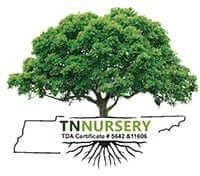
The Eastern White Pine
Share
The Eastern White Pine is a timeless native tree in the American landscape
There are many reasons to admire the Eastern White Pine Tree. It’s gorgeous. It’s vital to the natural ecosystem. It has proven itself adaptable and useful throughout American history. As one of the most abundant native pines in the eastern half of the country, it’s no wonder that Eastern White Pine Trees have a place in today’s landscapes, sustainable reforestation projects, and nature reserves.
We sell Eastern White Pine Trees for sale at TN Nursery. This fast-growing native is an attractive option for anyone looking to create a privacy screen, provide windbreak, or provide habitat for birds and pollinators. We sell Eastern White Pine Trees for sale in all stages of growth to suit your planting project.
From history to habitat: a long tradition of native beauty
Eastern White Pine isn’t just a tree; it’s a cultural icon. Its straight, tall trunk was used as masts for ships in early America. Some specimens are found in the largest old-growth forests and exceed 150 feet in height. Gardeners and conservationists are now drawn to Eastern White Pine for much more than its height and majesty. These trees are valued for their ecological benefits in the native plant community.
USDA Hardiness Zones 3 - 8, these trees are found naturally throughout the country’s northern and southern regions. They prefer draining soil and sun, but are relatively hardy once established. Its soft, flexible needles are packed into bundles of five. They create a bushy canopy that helps protect birds such as chickadees, nuthatches, and owls.
There are several good reasons to consider planting Eastern White Pine Trees in your landscape.
They can grow up to three feet a year and are great for fast impact.
Privacy: Dense pine needles and tall height help provide a natural boundary or buffer from strong winds.
Birds: Nest in the branches and use the thick needles as a nest material. Deer shelter in the branches during winter.
Rooting stability: Their extensive root systems stabilize soils on slopes and in degraded areas.
These native trees do well in monocultures or mixed with other natives. They benefit from surrounding native plants that create a more biodiverse ecosystem. Native ground covers and under story species grow well beneath the protective canopy of the pine. For example, Wild Ginger (Asarum canadense) and Solomon’s Seal (Polygonatum biflorum) can be found beneath the protective shade of a Pine Tree. These shade-loving native plants help keep a forest floor community and can also help suppress invasive weeds.
How to plant and care for Eastern White Pine Trees
Eastern White Pine is an easy-to-grow tree and a good choice for novice gardeners and landscape design students. Here are some tips for planting and caring for an Eastern White Pine Tree.
Site selection: Place in full sun with at least 20 feet of space from any buildings.
Soil conditions: wide range of soil types, Eastern White Pine prefers slightly acidic, sandy loam with good drainage.
Watering: Water regularly during the first year to keep the soil moist but not soggy. Once established, these trees become fairly drought-tolerant.
Mulching: Apply a layer of two to three inches of organic mulch around the base. Be sure to keep mulch away from the trunk.
Pruning: Eastern White Pine does not need much pruning unless you want to maintain a particular shape or lower branches removed for practical purposes.
You can purchase healthy, nursery-grown Eastern White Pine Trees for sale from TN Nursery. We will ship bare-root trees directly to your door for planting.
Choose companions: combining native plants for a low-maintenance landscape
To create a biodiverse and low-maintenance landscape, choose native plantings that provide a diverse habitat for a balanced ecosystem. Here are some attractive and functional companion native plantings to include in your Eastern White Pine landscape.
American Beautyberry (Callicarpa americana): A native shrub with vibrant purple berries that attracts birds and pollinators.
Blue Flag Iris (Iris versicolor): A moisture-loving native that blooms in the ground cover near a pond or swale below the tree.
Christmas Fern (Polystichum acrostichoides): A year-round green native that pairs well with pine needle mulch.
Virginia Creeper (Parthenocissus quinquefolia): A native vine that naturally climbs or can sprawl over the forest floor to add habitat and fall color.
Native planting isn’t just a passing trend; it’s essential for protecting local biodiversity and reducing pesticide use. According to the University of Minnesota Extension, native plantings benefit local wildlife and water quality by reducing runoff and limiting pesticide use.
TN Nursery plants natives for wildlife and clean air
TN Nursery grows natives that provide wildlife, clean air, and pollinator support. Our plants are sold bare root to reduce the amount of plastic used during shipping and to help reduce root loss during transport.
Along with Eastern White Pine Trees for sale, we also grow the Virginia Pine Tree, another native evergreen that is known for its rugged adaptation and fast growth. Shop our selection of plants here.
Final thoughts: the American legacy of the Eastern White Pine
Planting an Eastern White Pine on your property is more than a decorative choice; it’s an investment. These trees provide years of beauty, shade, habitat, and wind protection. Planting a Pine in a native plant landscape helps create a balanced community of interdependent plants. If you plant one in your front yard or a row for a privacy screen, you’ll reap the benefits of this American original for generations.
